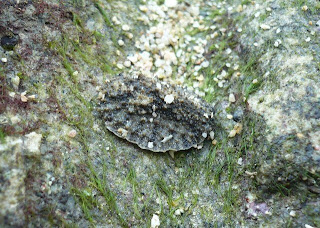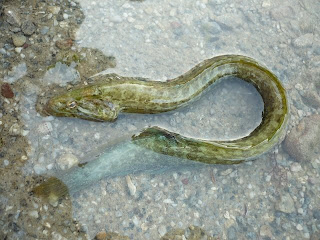It was one of the lowest spring tides in the annual calendar and we knew there would be so much to see.
The first creature that James and Bian found was the carpet eel blenny (Congrogadus subducens). I thought it was spelt ‘blarney’, haha, I was wrong. It has an olive-green body with dorsal fins going all the way to the back and joined to the tail fin. The poor fellow was stranded as the tide receded but luckily it managed to find a small pool of water. We left the eel where it was and went on in search of other sightings.
We were delighted to find a pair of Coastal Horseshoe Crabs (Tachypleus gigas). This species is listed as vulnerable due to its reduced populations as a result of pollution and loss of habitats. There are two species of horseshoe crabs in Singapore. The larger coastal horseshoe crabs is distinguished by its large grey shell and triangular serrated tail while the smaller mangrove horseshoe crab, which we often see at Chek Jawa, is brownish with a rounded (cross-section) tail.
Here are 2 picture of them doing the kind of stuff that horseshoe crabs do in nature. The kids asked me if the tails are stings. Well, they are not stings. The tail of the horseshoe crab helps to upright itself if it should accidentally flip over. With its legs shorter than its large shell, the horseshoe crab needs a prop to help it flip back up. How interesting! (Hey! Don’t you go flipping horseshoe crabs to test this. I’m sure you wouldn’t like it one bit if someone flips you over all the time).

There is truly life on the rocks. There are lots of snails, with and without shells on the tidal rocks. The top picture is of a nerite with a lovely orange-grey colour combination. The bottom picture is an onchidium, which we all call the "onch" with much affection. The "onch" does not have a shell, but its tough leathery flesh is well-camouflaged among the crevices of rocks.


Bian spotted a beautiful hard coral that was half submerged (picture above). So we were able to see the polyps blooming below the water, while the polyps above the water line have all retracted into the coral. It was a perfect live specimen to show to the kids.

Isn't this the Red Egg Crab? It has found itself a perfect hiding place under the giant tyre (I’m amazed by the kinds of trash we can find on our shores).
Actually there is no need for the red egg crab (Atergatis integerrimus) to hide. It is a poisonous crab and should not be eaten. Its bright colour serves as a warning signal to other marine animals, the red colour screams “Hey I am poisonous! Eat me if you dare!”
As for us human beings, it always pays to learn more about our local marine wildlife. That’s why the Naked Hermit Crabs believe in sharing this knowledge and we do this through our nature walks for the public.
Here is a close-up photo of the zoanthids or colonial anemones found in the large tidal pool, one of my favourite spots in the Sentosa shore. I often find myself drawn to this spot and could spend a long time here admiring the beautiful colours of the zoanthids and trying to count the different animal species. Zoanthids live in colonies like corals do, but they do not form a hard skeleton.
 And here is a photo (taken in 2007) of the same tidal pool.
And here is a photo (taken in 2007) of the same tidal pool.
And here is a photo of Ivan and his group after the walk.
It was indeed a lovely day out. What a privilege for us to spend a wonderful morning amongst the natural beauty that some of these unspoilt beaches still offer to ordinary people like you and me.
Our heartfelt thanks to our wonderful and enthusiastic visitors for joining us on our birthday nature walk. Maybe we don’t say it often enough, but your sense of wonder and child-like curiosity keep our hearts light and our passion glowing. Thank you!
Lastly, thanks go out to fellow Crabs – Haliah, Vyna, Bian, James, July and Ivan – for their time and effort for yet another successful Sentosa walk!
Some of the kids who came to this 6-June-08 walk also blogged of their experience:
Matthew's blog







HAPPY BIRTHDAY, NHC!
ReplyDeleteCongrats on sustaining your good work for Nature and the Environment! I am extremely proud and happy to read about your voluntary work in the local newspapers. You certainly deserved all the attention, recognition and accolades bestowed upon you.
Well done! Long-lived all NHC volunteers!
Joe Lai : )
Hi Joe, Thanks for the birthday wishes!
ReplyDeleteWe're hoping that through our educational walks, more people become the eyes and voice for the conservation of natural shores in SIngapore. /LK
Thank you Ko Ko Ivan for teachning us so much about snails.
ReplyDeleteHi Matthew, you're welcome! =D
ReplyDeleteGlad that you enjoyed yourself and learned so much.
Snails might seem boring because they don't move much, but once you read up about the different kinds of snails and how they live differently, it can get quite interesting.
Hope to see you again in future!
Ko ko Ivan